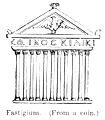Fastigium
(
ἀετός, ἀέτωμα). Literally, a slope; in architecture, a
pediment. The triangle which
 |
|
Fastigium. (From a coin.)
|
surmounts each end of a rectangular building, and which, in fact, represents the
gable end of the roof. (See
Antae.) It is composed of
the cornice of the entablature which forms its base, the two converging cornices at the sides,
and the
tympanum or flat surface enclosed by them, so called from its
resemblance to a three-cornered tambourine (Vitruv. iii. 3, iv. 6;
Cic. de Orat. iii. 46.180; Livy , xl. 2).
This flat surface was generally ornamented with sculpture; originally, in the early temples of
Zeus, with a simple eagle as a symbol of the god, an instance of which is afforded by the coin
represented in the above illustration (Beger,
Spicil. Antiq. p. 6), whence the
Greek name
ἀετός, which was at first applied to the
tympanum and afterwards to the whole pediment, and in after-times with
elaborate sculptures in high relief. See
Antefixa;
Templum.
The dwelling-houses of the Romans might have sloping roofs, but ornamental gables were not
allowed; hence, when the word is applied to them, it is not in its strictly technical sense,
but designates the roof simply, and is to be understood of one which rises to a ridge as
distinguished from a flat one (
ad. Q. Fr. iii. 1, 4.14;
Verg. Aen. viii. 491). Among other divine honours,
the Romans decreed to Caesar the liberty of erecting a fastigium to his house (
Plut. Caes. 81; see
Acroterium)— that is, a portico and pediment towards the street
like that of a temple. See
Domus.

